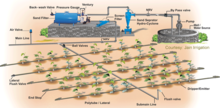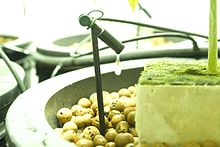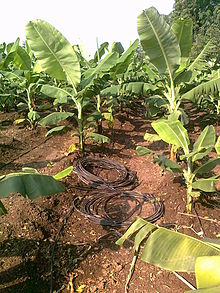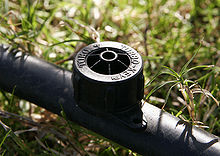Drip irrigation
This article needs additional citations for verification. (April 2014) |

Drip irrigation is a form of irrigation that saves water and fertilizer by allowing water to drip slowly to the roots of many different plants, either onto the soil surface or directly onto the root zone, through a network of valves, pipes, tubing, and emitters. It is done through narrow tubes that deliver water directly to the base of the plant. It is chosen instead of surface irrigation for various reasons, often including concern about minimizing evaporation.
History

Primitive drip irrigation has been used since ancient times. Fan Sheng-Chih Shu, written in China during the first century BCE, describes the use of buried, unglazed clay pots filled with water as a means of irrigation.[1] Modern drip irrigation began its development in Germany in 1860 when researchers began experimenting with subsurface irrigation using clay pipe to create combination irrigation and drainage systems.[2] Research was later expanded in the 1920s to include the application of perforated pipe systems.[3] The usage of plastic to hold and distribute water in drip irrigation was later developed in Australia by Hannis Thill.[4]
Usage of a plastic emitter in drip irrigation was developed in Israel by Simcha Blass and his son Yeshayahu.[5] Instead of releasing water through tiny holes easily blocked by tiny particles, water was released through larger and longer passageways by using velocity to slow water inside a plastic emitter. The first experimental system of this type was established in 1959 by Blass who partnered later (1964) with Kibbutz Hatzerim to create an irrigation company called Netafim. Together they developed and patented the first practical surface drip irrigation emitter.[2][6]
In the United States, the first drip tape, called Dew Hose, was developed by Richard Chapin of Chapin Watermatics in the early 1960s.
Modern drip irrigation has arguably become the world's most valued innovation in agriculture since the invention of the impact sprinkler in the 1930s, which offered the first practical alternative to surface irrigation. Drip irrigation may also use devices called micro-spray heads, which spray water in a small area, instead of dripping emitters. These are generally used on tree and vine crops with wider root zones. Subsurface drip irrigation (SDI) uses permanently or temporarily buried dripperline or drip tape located at or below the plant roots. It is becoming popular for row crop irrigation, especially in areas where water supplies are limited or recycled water is used for irrigation. Careful study of all the relevant factors like land topography, soil, water, crop and agro-climatic conditions are needed to determine the most suitable drip irrigation system and components to be used in a specific installation.
Components and operation



Components used in drip irrigation (listed in order from water source) include:
- Pump or pressurized water source
- Water filter(s) or filtration systems: sand separator, Fertigation systems (Venturi injector) and chemigation equipment (optional)
- Backwash controller (Backflow prevention device)
- Pressure Control Valve (pressure regulator)
- Distribution lines (main larger diameter pipe, maybe secondary smaller, pipe fittings)
- Hand-operated, electronic, or hydraulic control valves and safety valves
- Smaller diameter polytube (often referred to as "laterals")
- Poly fittings and accessories (to make connections)
- Emitting devices at plants (emitter or dripper, micro spray head, inline dripper or inline driptube)
In drip irrigation systems, pump and valves may be manually or automatically operated by a controller.
Most large drip irrigation systems employ some type of filter to prevent clogging of the small emitter flow path by small waterborne particles. New technologies are now being offered that minimize clogging. Some residential systems are installed without additional filters since potable water is already filtered at the water treatment plant. Virtually all drip irrigation equipment manufacturers recommend that filters be employed and generally will not honor warranties unless this is done. Last line filters just before the final delivery pipe are strongly recommended in addition to any other filtration system due to fine particle settlement and accidental insertion of particles in the intermediate lines.
Drip and subsurface drip irrigation is used almost exclusively when using recycled municipal waste water. Regulations typically do not permit spraying water through the air that has not been fully treated to potable water standards.
Because of the way the water is applied in a drip system, traditional surface applications of timed-release fertilizer are sometimes ineffective, so drip systems often mix liquid fertilizer with the irrigation water. This is called fertigation; fertigation and chemigation (application of pesticides and other chemicals to periodically clean out the system, such as chlorine or sulfuric acid) use chemical injectors such as diaphragm pumps, piston pumps, or aspirators. The chemicals may be added constantly whenever the system is irrigating or at intervals. Fertilizer savings of up to 95% are being reported from recent university field tests using drip fertigation and slow water delivery as compared to timed-release and irrigation by micro spray heads.
Properly designed, installed, and managed, drip irrigation may help achieve water conservation by reducing evaporation and deep drainage when compared to other types of irrigation such as flood or overhead sprinklers since water can be more precisely applied to the plant roots. In addition, drip can eliminate many diseases that are spread through water contact with the foliage. Finally, in regions where water supplies are severely limited, there may be no actual water savings, but rather simply an increase in production while using the same amount of water as before. In very arid regions or on sandy soils, the preferred method is to apply the irrigation water as slowly as possible.
Pulsed irrigation is sometimes used to decrease the amount of water delivered to the plant at any one time, thus reducing runoff or deep percolation. Pulsed systems are typically expensive and require extensive maintenance. Therefore, the latest efforts by emitter manufacturers are focused toward developing new technologies that deliver irrigation water at ultra-low flow rates, i.e. less than 1.0 liter per hour. Slow and even delivery further improves water use efficiency without incurring the expense and complexity of pulsed delivery equipment.
An emitting pipe is a type of drip irrigation tubing with emitters pre-installed at the factory with specific distance and flow per hour as per crop distance.
An emitter restricts water flow passage through it, thus creating head loss required (to the extent of atmospheric pressure) in order to emit water in the form of droplets. This head loss is achieved by friction / turbulence within the emitter.
Advantages and disadvantages

The advantages of drip irrigation are:
- Fertilizer and nutrient loss is minimized due to localized application and reduced leaching.
- Water application efficiency is high if managed correctly
- Field levelling is not necessary.
- Fields with irregular shapes are easily accommodated.
- Recycled non-potable water can be safely used.
- Moisture within the root zone can be maintained at field capacity.
- Soil type plays less important role in frequency of irrigation.
- Soil erosion is lessened.
- Weed growth is lessened.
- Water distribution is highly uniform, controlled by output of each nozzle.
- Labour cost is less than other irrigation methods.
- Variation in supply can be regulated by regulating the valves and drippers.
- Fertigation can easily be included with minimal waste of fertilizers.
- Foliage remains dry, reducing the risk of disease.
- Usually operated at lower pressure than other types of pressurised irrigation, reducing energy costs.
The disadvantages of drip irrigation are:
- Initial cost can be more than overhead systems.
- The sun can affect the tubes used for drip irrigation, shortening their usable life. (This article does not include a discussion of the effects of degrading plastic on the soil content and subsequent effect on food crops. With many types of plastic, when the sun degrades the plastic, causing it to become brittle, the estrogenic chemicals (that is, chemicals replicating female hormones) which would cause the plastic to retain flexibility have been released into the surrounding environment.)[7]
- If the water is not properly filtered and the equipment not properly maintained, it can result in clogging.
- For subsurface drip the irrigator cannot see the water that is applied. This may lead to the farmer either applying too much water (low efficiency) or an insufficient amount of water, this is particularly common for those with less experience with drip irrigation.
- Drip irrigation might be unsatisfactory if herbicides or top dressed fertilizers need sprinkler irrigation for activation.
- Drip tape causes extra cleanup costs after harvest. Users need to plan for drip tape winding, disposal, recycling or reuse.
- Waste of water, time and harvest, if not installed properly. These systems require careful study of all the relevant factors like land topography, soil, water, crop and agro-climatic conditions, and suitability of drip irrigation system and its components.
- In lighter soils subsurface drip may be unable to wet the soil surface for germination. Requires careful consideration of the installation depth.
- most drip systems are designed for high efficiency, meaning little or no leaching fraction. Without sufficient leaching, salts applied with the irrigation water may build up in the root zone, usually at the edge of the wetting pattern. On the other hand, drip irrigation avoids the high capillary potential of traditional surface-applied irrigation, which can draw salt deposits up from deposits below.
- the PVC pipes often suffer from rodent damage, requiring replacement of the entire tube and increasing expenses.
- Drip irrigation systems cannot be used for damage control by night frosts (like in the case of sprinkler irrigation systems)
Uses

Drip irrigation is used in farms, commercial greenhouses, and residential gardeners. Drip irrigation is adopted extensively in areas of acute water scarcity and especially for crops and trees such as coconuts, containerized landscape trees, grapes, bananas, pandey, eggplant, citrus, strawberries, sugarcane, cotton, maize, and potatoes.
Drip irrigation for garden available in drip kits are increasingly popular for the homeowner and consist of a timer, hose and emitter. Hoses that are 4 mm in diameter are used to irrigate flower pots.
See also
- Alkali soils
- Cation-exchange capacity
- Environmental impact of irrigation
- Index of soil-related articles
- Phosphogypsum
- Residual Sodium Carbonate Index
- Soil pH
- Soil salinity control
References
- ^ Bainbridge, David A (June 2001). "Buried clay pot irrigation: a little known but very efficient traditional method of irrigation". Agricultural Water Management. 48 (2): 79–88. doi:10.1016/S0378-3774(00)00119-0. Retrieved 23 October 2013.
- ^ a b R. Goyal, Megh (2012). Management of drip/trickle or micro irrigation. Oakville, CA: Apple Academic Press. p. 104. ISBN 978-1926895123.
- ^ "Drip Irrigation — History & Benefits".
- ^ "The History of the Drip Irrigation System and What is Available Now".
- ^ History of drip irrigation
- ^ The History of the Drip Irrigation System and What is Available Now
- ^ http://www.ncbi.nlm.nih.gov/pmc/articles/PMC3222987/
Further reading
- Irrigation, 5th Edition, Muhammad Irfan Khan Yousafzai, Claude H. Pair, editor, published by the Irrigation Association, 1983
- Trickle Irrigation for Crop Production, F. S. Nakayama and D. A. Bucks, editors, published by Elsevier, 1986, ISBN 0-444-42615-9
- S. Blass, Water in Strife and Action (Hebrew), published by Massada limited, Israel, 1973
- Maintenance Manual, published by Jain Irrigation Systems, 1989
- Drip and Micro Irrigation Design and Management for Trees, Vines, and Field Crops, 3rd Edition, by Charles M. Burt and Stuart W. Styles, published by the Irrigation Training and Research Center, 2007
